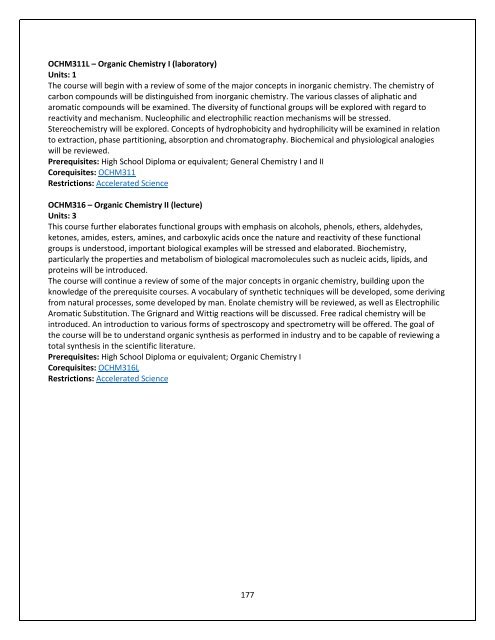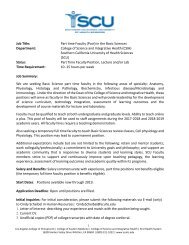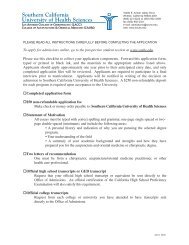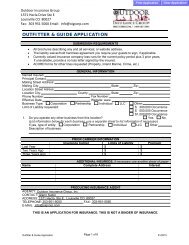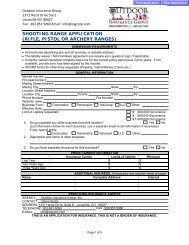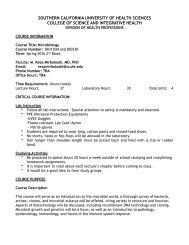Vision, Mission, and Guiding Principles for SCUHS
Southern California University of Health Sciences will be recognized as the premier evidence-based integrative healthcare university. in this PDF we are discussing about our Vision, Mission, and Guiding Principles. Please have a look. you can also go with this link: https://bit.ly/2JuIItL
Southern California University of Health Sciences will be recognized as the premier evidence-based integrative healthcare university. in this PDF we are discussing about our Vision, Mission, and Guiding Principles. Please have a look. you can also go with this link: https://bit.ly/2JuIItL
You also want an ePaper? Increase the reach of your titles
YUMPU automatically turns print PDFs into web optimized ePapers that Google loves.
OCHM311L – Organic Chemistry I (laboratory)<br />
Units: 1<br />
The course will begin with a review of some of the major concepts in inorganic chemistry. The chemistry of<br />
carbon compounds will be distinguished from inorganic chemistry. The various classes of aliphatic <strong>and</strong><br />
aromatic compounds will be examined. The diversity of functional groups will be explored with regard to<br />
reactivity <strong>and</strong> mechanism. Nucleophilic <strong>and</strong> electrophilic reaction mechanisms will be stressed.<br />
Stereochemistry will be explored. Concepts of hydrophobicity <strong>and</strong> hydrophilicity will be examined in relation<br />
to extraction, phase partitioning, absorption <strong>and</strong> chromatography. Biochemical <strong>and</strong> physiological analogies<br />
will be reviewed.<br />
Prerequisites: High School Diploma or equivalent; General Chemistry I <strong>and</strong> II<br />
Corequisites: OCHM311<br />
Restrictions: Accelerated Science<br />
OCHM316 – Organic Chemistry II (lecture)<br />
Units: 3<br />
This course further elaborates functional groups with emphasis on alcohols, phenols, ethers, aldehydes,<br />
ketones, amides, esters, amines, <strong>and</strong> carboxylic acids once the nature <strong>and</strong> reactivity of these functional<br />
groups is understood, important biological examples will be stressed <strong>and</strong> elaborated. Biochemistry,<br />
particularly the properties <strong>and</strong> metabolism of biological macromolecules such as nucleic acids, lipids, <strong>and</strong><br />
proteins will be introduced.<br />
The course will continue a review of some of the major concepts in organic chemistry, building upon the<br />
knowledge of the prerequisite courses. A vocabulary of synthetic techniques will be developed, some deriving<br />
from natural processes, some developed by man. Enolate chemistry will be reviewed, as well as Electrophilic<br />
Aromatic Substitution. The Grignard <strong>and</strong> Wittig reactions will be discussed. Free radical chemistry will be<br />
introduced. An introduction to various <strong>for</strong>ms of spectroscopy <strong>and</strong> spectrometry will be offered. The goal of<br />
the course will be to underst<strong>and</strong> organic synthesis as per<strong>for</strong>med in industry <strong>and</strong> to be capable of reviewing a<br />
total synthesis in the scientific literature.<br />
Prerequisites: High School Diploma or equivalent; Organic Chemistry I<br />
Corequisites: OCHM316L<br />
Restrictions: Accelerated Science<br />
177


